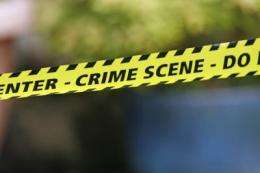Crime scene measurements can be taken from a single image

Two researchers from the University of Salamanca have developed a procedure to enable forensic police to extract metric data from crime scenes using just a single photograph. Their proposal, published this month in the Journal of Forensic Sciences, makes it possible to reconstruct a crime scene in 3D.
"We have studied an unprecedented and original line of research in the field of criminology and forensic engineering, which makes it possible to derive metric data from a single image", Diego González-Aguilera, co-author of the study and a researcher in the Department of Cartography and Soil Engineering at the University of Salamanca (in the University's Ávila offices), tells SINC.
González-Aguilera and his colleague Javier Gómez-Lahoz have recently published a study in the Journal of Forensic Sciences, which offers "a novel approach for documenting, analysing and visualizing crime scenes".
The process starts by capturing an image that must include easily-identifiable details and at least three vanishing points (the convergence point of straight lines projected in one direction) as well as at least one distance in the scene. These data are used to extract the structural components or most important objects in the image "automatically and robustly".
The researchers also calibrate the camera to be able to determine both the internal (focal distance, main point and radial distortion) and external (lens turns and lens viewpoints) parameters.
As the structural features are geometrically related to the features of the scene and the camera itself, it is possible to take measurements and to analyse the dimensions of the scene based on distances, angles and surfaces.
This means that, at any time after having taken a photograph of a crime scene, forensic police could establish that a knife was 32cm away from the victim, or that there was an angle of 37 degrees between a trace of blood, a footstep and a bullet hole.
González-Aguilera says it is better to use a single image rather than several as it is often difficult to ensure that a range of photos overlaps well, and there are always parts of the scene or some features of it that cannot be correctly related to the rest.
This technique has been developed within the field of photogrammetry, a procedure used to determine the geometrical properties of an object based on photographic images. "Until now, this discipline required at least two images to be used in order to reconstruct a crime scene, but now we have broken that barrier".
Reconstructing a two-dimensional image in 3D
Another basic principle of photogrammetry and computational vision (another discipline also used in this study) is that it is impossible to reconstruct a three-dimensional crime scene based on a single image. However, the new technology also overcomes this limitation, as it makes it possible to introduce known "restrictions" into the scene, such as the presence of parallel or perpendicular planes, enabling these to be represented in 3D.
An IT tool written in VRML format (Virtual Reality Modeling Language) is used in order to visualise a crime scene from any viewpoint in an interactive and three-dimensional way. VRML is a "flexible, scalable and easy-to-use" language, designed specifically for this task.
More information: Diego González-Aguilera y Javier Gómez-Lahoz. "Forensic Terrestrial Photogrammetry from a Single Image". Journal of Forensic Sciences 54 (6): 1376-1387, Nov 2009.
Source: FECYT - Spanish Foundation for Science and Technology




















